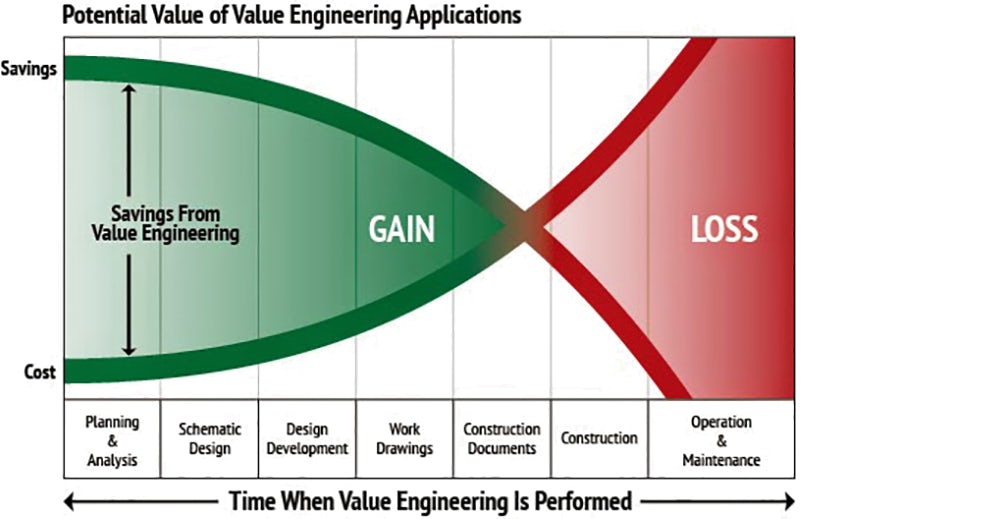Connect with huge architecture firms and gain new business through Architizer’s community marketplace for building-products. Click here for more information.
It’s a cruel but common scenario for building-product manufacturers.
You build a great relationship with an innovative architecture firm, leading to your product being selected in the specifications of its latest project — a huge win for your company. But just before you begin celebrating, you find it’s happened again: Your product has disappeared from the construction documents, replaced with another, usually cheaper, alternative. You have been value engineered out of the project, and with it your biggest sale is ancient history.
Value Engineering (VE) can be defined as “an organized effort directed at analyzing designed building features, systems, equipment and material selections for the purpose of achieving essential functions at the lowest life cycle cost.” What does this mean in real terms? If there is a cheaper building-product available that can adequately perform the same function, VE comes into play and specifications are amended accordingly, with the manufacturer of the original selection missing out.
Despite how harsh this sounds, it’s important to note that value engineering is not inherently bad. If practiced correctly, the process can benefit the architect’s client by offering optimized, cost-effective solutions for a project. However, the process is often mismanaged, leading to the selection of lower-quality products that benefit the general contractor’s profit margins to the detriment of the client’s building, the architect’s reputation and many a manufacturer’s business.

The economic benefit of implementing VE diminishes over the life of a project, so product specifications should be fixed before the construction phase; chart via LinkedIn
So, what’s a manufacturer to do? In order to avoid becoming a victim of VE late on in a project, there are some fundamental steps you can take. Keep these points in mind next time you are in discussion with specifying architects on Architizer:
1. Understand the project needs.
Work on gaining a deep understanding of the architect’s needs in terms of performance, project life cycle and required compatibility with other building-products. This will allow you to recommend the best possible solution for their needs from a functional perspective, reducing the likelihood of value engineering further down the line.
2. Be a key player in the specification process.
According to the AIA, manufacturers are the second-most-relied-upon influencers in the specification process after architects; take advantage by offering your services. By helping to define the key performance criteria, operating costs and maintenance requirements, you can ensure your product aligns with the specifications on all of these factors, providing the architect with an optimized solution.
3. Start the conversation early.
Wherever possible, representatives should aim to engage with architects and help consult on project specifications throughout the early stages, from concept design to technical design. Be proactive — bring up the issue of value engineering before it has occurred, explaining its potential benefits and risks. By being transparent, architects and engineers are more likely to heed advice when you …
4. Highlight the consequences of selecting substitutions.
If after taking all of these steps, it still appears likely that your product is going to be value engineered out of the project, make sure that every party understands the consequences of that decision. Remind architects under pressure from thrifty contractors that specification is not just about basic performance — qualities pertaining to long-term maintenance requirements and energy efficiency are also crucial when calculating the lifetime costs for a project.

Via iStock, credit: Madmaxer
Ultimately, the key is to promote the specific benefits of your building-product throughout the design process. As visual people, architects will naturally gravitate towards materials with great aesthetic qualities, but your technical knowledge will help them weigh these properties against key performance factors when making their specifying decisions. When it comes to VE, architects will appreciate your insights.
The good news is that it’s now easier than ever to communicate these points to specifying professionals. Architizer’s user-friendly messaging service allows manufacturers to keep track of conversations with dozens of architects all in one place, allowing you to be present throughout the decision-making process, including VE. Furthermore, the ability to highlight key performance data through Architizer means that manufacturers can put actively specifying architects in the picture from the outset.
The advent of BIM and other rapid quantification tools has made it much easier for different project collaborators to view performance data and suggest alternative materials, products and systems, so the business of VE is bigger than ever. For manufacturers, there has never been a better time to become an expert on the subject and position themselves for success.
Gain leads from major firms such as AECOM, HOK and OMA through Architizer’s community marketplace for building-products. Click here to sign up now.
Top image via iStock, credit: kitzcorner




